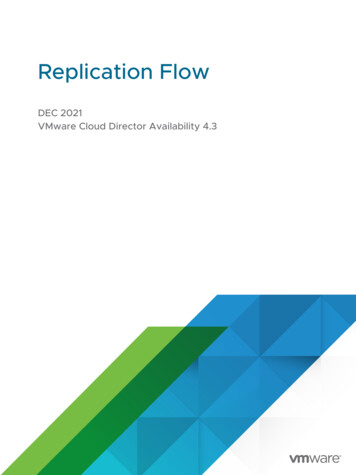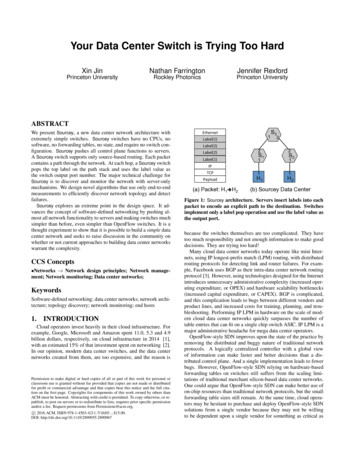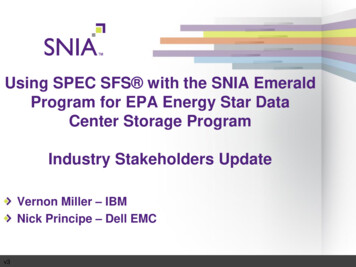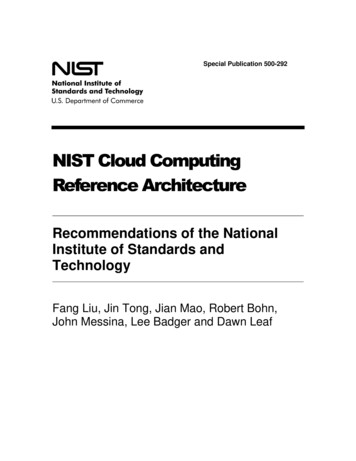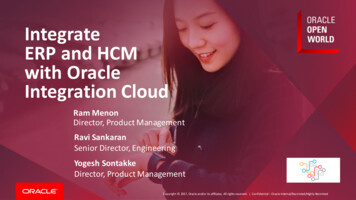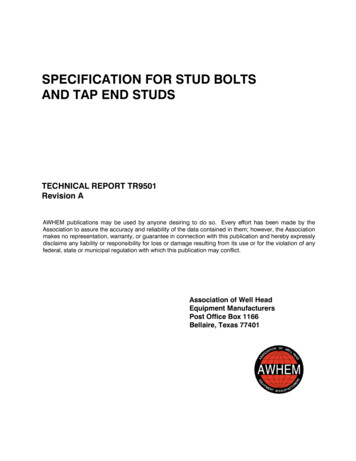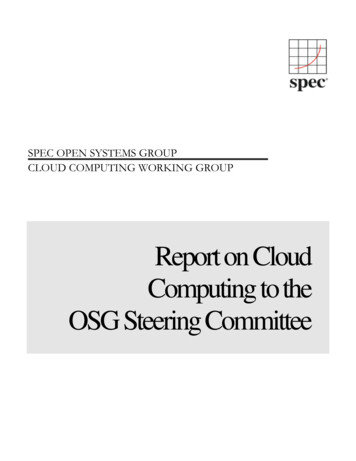
Transcription
SPEC OPEN SYSTEMS GROUPCLOUD COMPUTING WORKING GROUPReport on CloudComputing to theOSG Steering Committee
Table of ContentsIntroduction and Objectives . 31Cloud Computing . 51.1Definition of the Cloud . 51.1.11.1.21.1.31.2Interested parties of a Cloud Benchmark . 61.2.11.2.21.323Participants . 7Cloud Benchmark Audience Types . 7Cloud Computing Use Cases . 81.3.11.3.21.3.31.4Characteristics . 5Service Models . 6Deployment Models . 6Computing Use Cases . 8Use Case to Customer Map . 9Use Case to Processing Type Map . 10Existing Cloud Frameworks . 11Benchmark Considerations . 122.1What is a Cloud SUT? . 122.2SUT Components . 132.3Full Disclosure Report (FDR) Requirements . 14Relevant Cloud Metrics . 163.1Elasticity . 163.2Response Time . 193.3Throughput . 193.4Variability . 213.5Durability . 213.6Reliability . 213.7Availability . 223.8Power . 233.9Price . 23
3.10456Density . 24What Makes a Benchmark a Cloud Benchmark? . 244.1Cloudizing an Existing Benchmark . 254.2Cloudize Existing SPEC Benchmarks . 264.3Dos and Don’ts of Benchmarking a Cloud . 27Tools to Measure Cloud Metrics . 285.1AEOLUS (Red Hat) . 285.2BITT (Intel) . 295.3CloudBench (IBM) . 30OSG Cloud Subcommittee . 316.1Cloud Subcommittee Charter . 316.2Subcommittee specific Issues . 31Appendix A. OSG Cloud Contributors. 32Appendix B. Cloud Computing Use Cases . 33Appendix C. CloudBench Description . 37Introduction . 37Experiment 1 . 41Experiment 2 . 42How does CloudBench collect performance data? . 45How does CloudBench incorporate new benchmarks and workloads? . 47CloudBench Instantiation on Amazon EC2 . 47Metrics . 48How is CloudBench different from SPECvirt? . 49Appendix D. Bibliography . 50
O S GC L O U DW GIntroduction andObjectivesWith Cloud Computing on the rise, there is a need to monitor and measure theperformance of cloud systems. To address this issue, SPEC started twoseparate working groups to investigate this area: one under the Research Group(RG) and the second under the Open Systems Group (OSG). This documentcovers the investigations and recommendations from the OSGCloud workinggroup.The OSGCloud working group was formed with the main goal to research andrecommend application workloads for cloud computing in collaboration withother osg sub-committees and the Research working group. The list of goalsincluded the following: Help develop a cohesive cloud picture for OSG.Develop a consensus definition of cloud computing.Identify where the working group fits within the OSG spectrum.Collaborate with OSG sub-committees to define the cloud picture.Recommend a common framework for cloud benchmarks.Investigate potential cloud metrics and identify which metrics are mostrelevant for various SPEC benchmarks.Create a set of guidelines for OSG subcommittees to use when theycreate benchmarks in the cloud computing context.Determine and recommend application workloads for cloud computing.REPORT TO OSSC3
O S GC L O U DW GIn contrast, the RG Cloud Group takes a broader approach relevant for bothacademia and industry. Benchmarks developed by this group are intended to beused to gain larger understanding of Cloud behavior and performance. Themain goal of research benchmarks is to provide representative applicationscenarios, defined at a higher level of abstraction that can be used as a basis toevaluate early prototypes and research results as well as full-blownimplementations of Cloud platforms.E X E C U T I V ES U M M A R YThe OSG Cloud Working Group investigated its assigned goals from April2011 to February 2012. The group based its definition and industryconventions on the NIST Cloud Computing publication, originally published asa draft, and ultimately a final document in September 2011. From this base, theWorking Group has identified three classes of interested parties to Cloudbenchmark results: Hardware/Software-Vendors, Cloud-Providers and EndConsumers. These three parties form two distinct relationships which definetwo types of benchmarks: Black Box and White Box. These two benchmarktypes have both conflicting and common requirements, which are highlightedthroughout the document. We identified Cloud Computing specific metrics anddefine them in Section 3. Some Cloud metrics will have benchmark specificvariations, while others remain constant across all benchmarks. Section 4.1 and4.2 contain some initial steps to consider when converting a benchmark to runin a Cloud.The OSGCloud members recommend the following:1) Creation of an OSG Cloud subcommittee with an initial charter describedin Section 6.1.REPORT TO OSSC4
O S GC L O U DW G1 Cloud Computing1.1 Definition of the CloudWe adopted the definition of cloud computing from the NIST Special PublicationNo. 145 [ (Mell & Grance, 2011)], which defines Cloud Computing as:Cloud computing is a model for enabling ubiquitous,convenient, on-demand network access to a shared pool ofconfigurable computing resources (e.g., networks, servers,storage, applications, and services) that can be rapidlyprovisioned and released with minimal management effort orservice provider interaction.Three roles exist within cloud computing. Cloud-Providers sell computing orsoftware services purchased by the End Customer/Consumer. A Cloud-Providerbuilds its cloud using products from various Hardware and Software Vendors. SeeSection 1.2 (Interested parties of a Cloud Benchmark) for a more detaileddiscussion.The NIST document describes five essential cloud characteristics, three servicemodels, and four deployment models. We briefly describe these below, based onthe NIST document.1.1.1 CharacteristicsCloud Computing has five essential characteristics, namely:1. On-demand self-service, where a consumer can provision compute and storagecapabilities without requiring human intervention from provider.2. Broad network access, where a consumer can access compute and storagecapabilities over the network.3. Resource pooling, where a provider groups together resources such as CPU,memory, disk, and storage to serve multiple consumers.4. Rapid elasticity, where resources used can be rapidly and in some casesautomatically increased or decreased to handle demand.5. Measure service, where the service used a consumer is metered.1The definition does not mandate the use of virtualization for a Cloud.REPORT TO OSSC5
O S GC L O U DW G1.1.2 Service ModelsThere are three service models for cloud computing. They affect the definition of aSystem Under Test (SUT) for any cloud benchmarks. The following are a briefdescription of the service models.Infrastructure as a The Service Provider gives the End-Consumer the capability to the provisionService (IaaS)processing, storage, network, and basic computing resources. They can also deployand run arbitrary operating systems. The End-Consumer does not manage orcontrol the underlying physical cloud infrastructure, but has control over theoperating system, assigned storage, deployed applications, and limited control ofselect networking components (e.g., host firewalls).Platform as aService (PaaS)The Service Provider gives the End-Consumer the capability to deploy consumercreated or acquired applications created using programming, languages, libraries,services, and tools supported by the Service Provider. The Service Provider retainscontrol and manages the underlying cloud infrastructure, including network,servers, operating systems, and physical storage. End-Consumer has control overthe deployed applications and configuration settings for the application-hostingenvironment.Software as aService (SaaS)The Service Provider gives End-Consumer the capability to use the provider’sapplications running on a cloud infrastructure. The applications are accessible fromvarious client devices through either a thin client interface, such as a web browser(e.g., web-based email), or a program interface. The Service Provider retainscontrol and manages the underlying cloud infrastructure, including individualapplications, these application configurations, network, servers, operating systems,and physical storage. The End-Consumer might have limited control of userspecific application configuration settings.1.1.3 Deployment ModelsThe NIST document defines four deployment models, namely,Private cloudThe cloud is configured for exclusive use by one or more organizations.Public cloudThe cloud is configured for use by the general public.Hybrid cloudThe cloud is a composition of distinct infrastructures in order to retain theproprietary technology by the consumer.Community cloudThe cloud is provisioned for exclusive use for a community of consumers.1.2 Interested parties of a Cloud BenchmarkThere are at least three categories interested in the development and use of a cloudbenchmark. Between these three parties exists two relationship types.REPORT TO OSSC6
O S GC L O U DW G1.2.1 ParticipantsThe three identified parties are:Cloud-Providersbuild data centers using standard hardware, network, and management software.Amazon, IBM, HP, VMWare, Microsoft, Oracle and Terremark are examples ofcompanies that provide public or enterprise IaaS, Paas or SaaS clouds. They willbe interested in publishing the benchmark results of their service offerings. Theywould also be interested in the benchmark results of hardware, software or networkvendor products, and how these components support the performance of theirservice.Hardware andSoftware Vendorsprovide the hardware (computers, blades, or servers) and software (virtualization,management, automation) products used to build the cloud. AMD, HP, Intel, IBM,VMWare, OpenStack, Oracle, Red Hat, and VMware are examples of companiesthat might publish benchmark results for their customers.End-Consumerscloud customers might use cloud benchmark results to help select a CloudProvider. These are primarily businesses. While there exist several collaborationand social apps used by individuals, the recommendations in this document will notaddress the needs of this community. We restrict our attention to business users ofthe cloud.1.2.2 Cloud Benchmark Audience TypesBased on the above, use of cloud benchmarks fall into two broad categories:White BoxbenchmarkdisclosuresPublished by one or more Hardware/Software Vendors and used by CloudProviders to determine the right set of hardware and software products to deploy intheir cloud. Cloud-Providers can also publish results of the hardware and softwarecomponents used in their cloud.Black BoxbenchmarkdisclosuresPublished by Cloud-Providers and used by End-Consumers to determine theappropriate cloud service provider for their application needs.DIFFERENCESA given workload can be tested either in the black-box or white-box context. Eachhas differing implications for reporting and comparability, usually addressable bythe Run Rules defined for the released benchmark.White BoxBenchmarkThe SUT’s exact engineering specifications is known and under the control of thetester.The benchmark results allow full comparisons, similar to existingbenchmark results.REPORT TO OSSC7
O S GBlack BoxBenchmarkC L O U DW GThe Cloud-Provider provides a general specification of the SUT, usually in termsof how the End-Consumer may be billed. For example, an end user of a cloud mayrent a cloud platform under the description of “2 compute units.” The exacthardware details corresponding to these compute units may not be known. Due tothis vagueness or incompleteness, comparing benchmark results requires additionalinformation not currently collected or mandated. For example, the benchmarkdisclosure may include additional conditions, such as time and place wheremeasurements were collected, or dynamic changes to the SUT during the collectionperiod.1.3 Cloud Computing Use CasesThe OSG Working Group identified general classes of computing and mappedthese to the Research Group’s processing types.1.3.1 Computing Use CasesThe general class of applications either use cloud computing infrastructure or mighttransition all or subsets to cloud computing. See Appendix A for more details onservices and usage of each type.Social NetworkingUsers access web servers to exchange messages with others, update information,view recommendations or endorsements, and otherwise interact with other users,both in real time and not.The CloudBench/Olio benchmark currently simulates this collection of web serveractivities, and scales by controlling the number of concurrent users.CollaborationA group of users share the same view and access into a data set. Access can bethrough standard web browsers, custom plug-ins, or proprietary client software.Mail / MessagingPrivate business e-mail servers can be easily moved to outsourced e-mail services.Some of these companies run on private or public infrastructure clouds. Moresophisticated e-mail services or a portal site will interface with social networking,calendar services, 3rd party remote services, user profiling (for targeted ads), andother non-e-mail things,Data AnalyticsMany companies and groups are using the large clusters of hosts to evaluate largedata sets (log files; personal information; user comments on shows, books, orevents; interesting conversations), or extract sophisticated findings from multilayered data sets, with complex relationships.REPORT TO OSSC8
O S GC L O U DW GData Warehousing/ MiningThis computing category builds on large sets of both structured and unstructureddata for later use by other types.NoSQL DatabasesThese non-relational databases can support peta-byte scale data sets, distributedacross hundreds to thousands of machines. They are used where ‘weak consistencyguarantee’ policies suffice. Real-time web applications, document databases,graph databases, key-value data stores are among some current applications of thistechnology.Business OLTPThis long-standing processing type is characterized by high data I/O volumes andwell defined data sets. Both real-time and scheduled processing exist.Memory CloudA group of machines maintain a coherent and shared data space used by manyother types. It is typically used by multi-layered software, that also have latencyrequirements.HPCHigh-performance computing (HPC) uses supercomputers and computer clustersto solve advanced computation problems. This genre of workloads also includesengineering, simulation, graphics and data applications that run on cluster-basedsystems.On-line GamingSimilar to social networking or collaboration, but also maintain time-sensitiveservicesStreamingAudio/VideoAn increasing number of consumers access music, books, or videos from variousmedia distribution companies.Voice over IPDigital VoIP services are replacing and expanding audio communications for manyconsumers and companies. This includes both audio and video transmissionsacross the Internet, with stringent latency and computational needs.1.3.2 Use Case to Customer MapThe following table identifies potential customers. It identifies companies orindustries known to use the Research Group’s processing types. The OSG WorkingGroup also polled members and other interested parties as to the usefulness orcriticality of a cloud benchmark in this processing category.REPORT TO OSSC9
O S GC L O U DW GProcessingTypesPotential AudienceLinkedIn, Facebook, Twitter, Yelp,Social Googleplus, Groupon, Goodreads,Networking Netflix (Social net component), Amazon(Social net component), WorkpressCollaboration3WebEx Screen sharing, Citrix GoToMeeting,Skype, Microsoft Live MeetingCloud providers, existing Internet Serviceproviders (AOL, cable operators, internetMail / Messaging portals), E-mail Outsourcing providers, e-mailfiltering services, Mid to large sizedcompanies.Data AnalyticsSurveyScoreCloud providers, SaaS providers, mobile phonecompaniesDataWarehousing / Cloud providers,MiningNoSQL Amazon, Facebook, Twitter, Yahoo, Digg,Databases Hadoop users3.434.4342.44Business OLTP Business users of databases, enterprises3.56Web Service users,Social Network users3Memory CloudHPC Cloud service providersGame providers,On-line Gaming Cloud providers for games;Government, military2.57TV networks, Apple TV, Google TV, InternetStreamingRadio, Netflix, iTune, YouTube, Onlineaudio/videoUniversitiesVOIP SPEC SIP customers,1.3.3 Use Case to Processing Type MapThe following table shows which (Research Group’s) Processing Type is present ineach Cloud Computing Use Case.REPORT TO OSSC10
Processing Pipelines Dynamic Websites Business Processing / OLTP /Mission Critical applications VOIP Streaming audio/videoBusiness OLTP On-line GamingNoSQL Databases HPCData Warehousing / Mining Collaboration Social NetworkingData-Intensive / Planned Batch JobsProcess TypeMemory CloudW GMail / Messaging (IM, Tweets)Data AnalyticsC L O U DCloud Use CaseO S G Latency Sensitive Application Extensions / Backendsfor Mobile Communications Bandwidth and Storage Intensive Mail Applications Others 1.4 Existing Cloud FrameworksThe Research cloud working group has summarized a list of publiclyavailable cloud g-portal/links.html.The OSG Cloud Working Group presents the following assome of the better known and available cloud benchmarks.BenchmarkYCSBFeatures Evaluate performance of key-value baseddatabases Measures ElasticityREPORT TO OSSCSourceYahoo! Research athttp://research.yahoo.com/Web Information Management/YCSB11
O S GC L O U DW GBenchmarkFeaturesSourceCloudstone/ Olio Workloads: Web 2.0, MySQL, PostgressSQL,and Memcached By default, runs against Amazon EC2 but hasinstructions on how to set up in other cloudsBerkeley RAD Lab project dstoneMalstone Distributed, data intensive computingworkload, using synthetic data to determineinfection rates by website to its visitors.Open Cloud Consortium projectathttp://code.google.com/p/malgen/Hadoop Several workload types: cpu, map reduce,machine learning, parallel computation,distributed file system, and distributeddatabases Used by many 3rd party benchmarks No strict Run RulesOpen source project athttp://hadoop.apache.orgCloudHarmony Measure performance of black box clouddeployments using various workloads Offers comparison of various benchmarkresults as a paid servicehttp://www.CloudHarmony.com2 Benchmark Considerations2.1 What is a Cloud SUT?Defining SUT for a cloud benchmark is challenging due to conflicting goals ofinterested parties and different cloud service models. As discussed in earliersections, an End-Consumer does not have knowledge of the physical infrastructurefor IaaS, PaaS, or a SaaS service. However, Hardware and Software Vendors areone of the interested parties in a cloud benchmark. In order for a cloud benchmarkto have any useful meaning for these vendors, the physical infrastructure shouldalso be part of the results that a cloud benchmark reports. However, mandating thereporting of physical infrastructure results is problematic, because it will excludebenchmarking many existing public Cloud-Providers.The System Under Test (SUT) comprises all components (cloud service, hardware,software, network connections within the SUT, and support services which arebeing tested by the cloud workload or required by the specific benchmark run rules.It does not include any client(s) or driver(s) necessary to drive the cloud workloador the network connections between the driver(s) and SUT.REPORT TO OSSC12
O S GC L O U DW GBy existing SPEC benchmark convention, the System Under Test (SUT) comprisesall components (cloud service, hardware, software, network connections within theSUT, and support services which are being tested by the cloud workload orrequired by the specific benchmark run rules. It does not include any client(s) ordriver(s) necessary to generate the cloud workload, nor the network connectionsbetween the driver(s) and SUT.Mandating the disclosure of the physical infrastructure presents many problems dueto the conflicting goals of interested parties and different cloud service models.Hardware and Software Vendors provide benchmark results to their, the CloudProviders, who derive the most useful meaning through the detailed description ofthe physical infrastructure and the corresponding results. However, an EndConsumer has little to no knowledge of the Cloud-Provider’s physicalinfrastructure for IaaS, PaaS, or a SaaS service. Providing such a detaileddescription is impossible without a Cloud-Provider’s cooperation. Therefore, amandate that reports must include the details of the physical infrastructure isproblematic, because it will exclude benchmarking many existing public CloudProviders.2.2 SUT ComponentsThe actual set of SUT’s constituent pieces differs based on the relationship betweenthe SUT and the tester.Black Box Cloud The SUT consists of a description of the specific cloud offering used to run theworkload with sufficient detail to meet Full Disclosure Report (FDR)Requirements as described in Section 2.3 and the specific benchmark'sreproducibility requirements on and instance of the same offering.White Box Cloud The SUT description can be more specific, similar to many existing SPECbenchmarks. These SUT descriptions consist of: Comment 1Comment 2The host system(s) (including hardware and software) required to supportthe Workload and databases. All network components (hardware and software) between host machineswhich are part of the SUT and all network interfaces to the SUT. Components which provide load balancing within the SUT. All software that is required to build, deploys, and run the specificbenchmark workload.Any components which are required to form the physical TCP/IP connections(commonly known as the NIC, Network Interface Card) from the host system(s) tothe client machines are considered part of the SUT.A basic configuration consisting of one or more switches between the Driver andthe SUT is not considered part of the SUT. However, if any software/hardware isused to influence the flow of traffic beyond basic IP routing and switching, it isconsidered part of the SUT. For example, when DNS Round Robin is used toREPORT TO OSSC13
O S GC L O U DW Gimplement load balancing, the DNS server is considered part of the SUT andtherefore it must not run on a driver client.2.3 Full Disclosure Report (FDR) RequirementsFor both Black Box and White Box cloud types, the Full Disclosure Report (FDR)must include a detailed description of the SUT, often referred to as a 'Bill ofMaterials' (BOM). The intent of the BOM is to enable a reviewer to confirm thatthe tested configuration satisfies the run rule requirements and to document thecomponents used with sufficient detail to enable a customer to reproduce the testedconfiguration and obtain pricing information from the supplying vendors for eachcomponent of the SUT.The SUT description or BOM must reflect the level of detail a customer would seeon an itemized bill. It should list individual items in the SUT that are not part of astandard package. For each item, the BOM should include the item's supplier,description, the item's ID (the code used by the vendor when ordering the item),and the quantity of that item in the SUT.For example, a black box SUT for Amazon EC2 may be described as:Supplier:Description:AmazonSmall vm with1.7 GB memory1 EC2 Compute Unit (1 virtual core with 1 EC2 Compute Unit)160 GB instance storage32-bit platformI/O Performance: ModerateRegion:US East coastZone:portion with region where VM is :API name: m1.smallQuantity:1 (collocation details if the quantity is greater than 1)Date and time of use:An example of a White Box description may be similar to the one es2011q3/jEnterprise201020110727-00023.html#bill of materialsREPORT TO OSSC14
O S GC L O U DW GSupplierDescriptionApplication ServerOracleSun Blade X6270 M2 Base AssemblyOracle3.46GHz Intel 6-Core Xeon X5690Oracle4GB Registered DDR3-1333 DIMMOracleMemory filler panelOracle300GB - 10K RPM SAS DiskOracle6Gbps SAS-2 RAID Expansion ModuleOraclePremier Support for Systems 3 yearsDatabase ServerOracleSun Blade X6270 M2 Base AssemblyOracle3.46GHz Intel 6-Core Xeon X5690Oracle8GB Registered DDR3-1333 DIMMOracle2.5in HDD Filler PanelOracleSun Storage 6180 ArrayOracle300 GB - 15000 rpm FC-AL HDDOracle6Gbps SAS-2 RAID Expansion ModuleOraclePremier Support for Systems 3 yearsBlade Server EnclosureOracleSun Blade 6000 Modular SystemOracleDual 10GbE 10GBE SFP PCIeExpress ModuleOracle10 GigE Dual Rate SFP SRTransceiver, MMFOracle8GB PCI-E Dual FC/GbE Host AdapterEMOraclePower cord, QTY4, AC Input 20AOraclePremier Support for Systems 3 yearsOracleOracleOracleOracleOracleOracleProduct -NQ-PREM-SPRT-SYSOracle Linux Basic Support for 3 yearsOracle Database 11g Enterprise Edition, Per ProcessorUnlimited Users for 3 yearsPartitioning, Per ProcessorUnlimited Users for 3 yearsOracle Premium Support for 3 yearsOracle WebLogic Server Standard Edition Release 10.3.5Per Processor for 3 yearsOracle Premium Support for 3 years1126*6*26*1(* 6 0.5 * 12) Explanation: For the purposes of counting the numberof processors which require licensing, a multicore chip with 'n' cores shall be determined bymultiplying 'n' cores by a factor of 0.5REPORT TO OSSC15
O S GC L O U DW G3 Relevant Cloud MetricsMetrics are used as the measurement criteria for the tests. The following metricshave been identified as being the key indicators of performance for most workloadsin a Cloud environment. Note: Due to the breadth of cloud implementations, not allmetrics will be applicable to each benchmark. For instance, if End-Consumer testsa public cloud, the density and power metrics are typically not measurable.The key metrics identified are: Elasticity, which consists of at least the following components Provisioning Interval Agility Scaleup/Down Elastic speedup Throughput Response time VariabilityOther relevant metrics include: Durability Reliability Power Price DensityThe nature of the cloud makes these metrics, while relevant, difficult to measure inthe context of benchmarking. These metrics also do not represent quantifiableengineering metrics.3.1 ElasticityElasticity has become a key component and buzz word when talking about cloudservices. The term has become synonymous with how quickly a service can adaptto the changing needs of the customer. Thus, a highly elastic system can scale toinclude newer instances, as well as quickly provision those instances. Based on this,we define two metrics to characterize the term Elasticity.The exact definitions of the metrics captured under Elasticity will vary based on theservice model and SUT definition.ProvisioningintervalProvisioning Interval is defined as the time needed to bring up or drop a resource.This is the time be
1 Cloud Computing 1.1 Definition of the Cloud We adopted the definition of cloud computing from the NIST Special Publication No. 145 [ (Mell & Grance, 2011)], which defines Cloud Computing as: Cloud computing is a model for enabling ubiquitous, convenient, on-demand network access to a shared pool of



